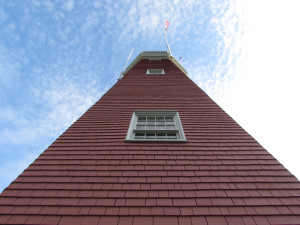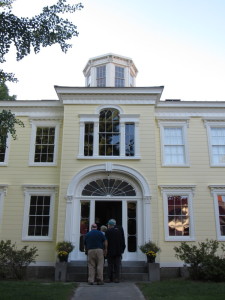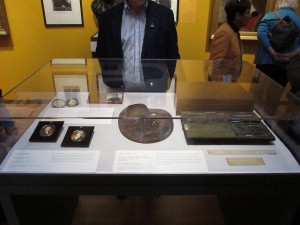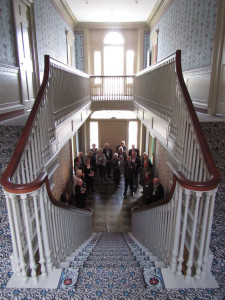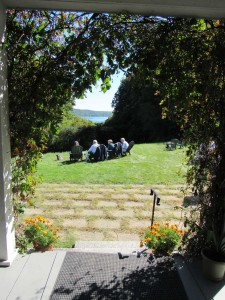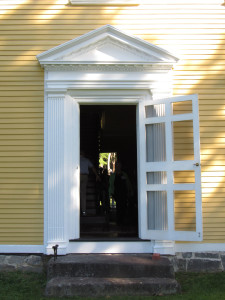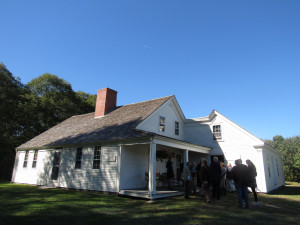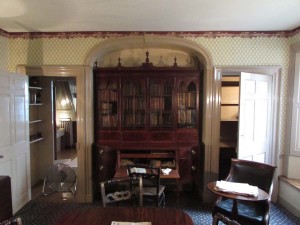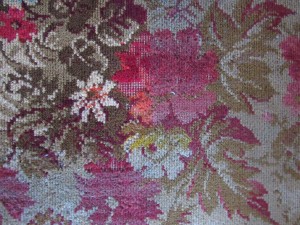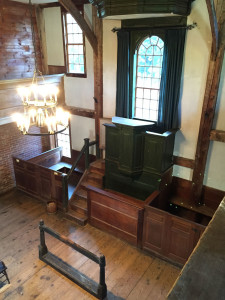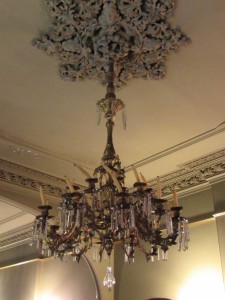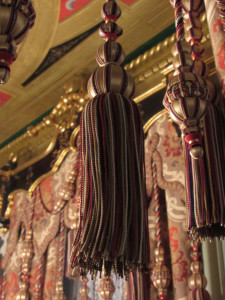Maine’s Southern Coast
EVENTS > SYMPOSIA > REVIEW: Maine’s Southern Coast
In Review: The Decorative Arts Trust Fall Symposium, 2015
Following a well-established tradition of Maine tourism, Trust members gathered in late September for four days of sensory immersion along the state’s southern coastline. Visiting sites ranging from the jaw-dropping collections and exhibitions at Bowdoin College in Brunswick to the jaw-clenching condition of the Skolfield-Whittier House down the street, our sold-out crowd bore witness to the full array of art and architecture that represents Maine’s maritime history.
Although a lightly populated state in a far corner of the country, Maine boasts museums and collections that were ripe for our appreciation and enjoyment. The impressiveness of the Portland Museum of Art, Bowdoin, and the bevy of historic houses and private collections on the southern coast provide sufficient evidence in support of this theory. The PMA is in the final stages of a transformative renovation project that is drawing renewed interest in its top-tier collection. Although the American decorative arts collection has not yet benefited from a gallery makeover, our members were the first to enjoy a new study room that provides small groups with a space to examine items from the museum’s holdings in an intimate setting. Curatorial fellow Diana Greenwold provided such an experience for us having assembled a varied selection of objects representing the breadth of the institution’s collecting interests.
Diana also set the stage for the evolving interpretation of the adjacent McClelland House, which now features a study of contrasts via exquisite, period-appropriate reproduction carpets and wallpaper as a backdrop for installations of both historic and contemporary art. While some traditionalists may have longed for a sympathetic display of Federal-period objects, progressive visitors admired the leap of faith to draw new audiences into a truly stunning neoclassical edifice. We all appreciated the dwelling’s grand flying staircase and the Museum’s effort to draw connections between Portland’s early-19th-century prosperity and the city’s contemporary community.
Historic house museums along the southern coast run the gamut from sublime to struggling. The homes of revered historical figures are always worthy of our interest, particularly because their headstrong owners often turned to creative methods to shape their domestic worlds. In Henry Wadsworth Longfellow’s Portland home, whose interiors were judiciously reinstalled by our speaker Laura Sprague, we encountered a neoclassical sideboard that Longfellow converted into a desk and bookcase. Joshua Chamberlain, of Gettysburg fame, appears to have served as architect for the exceedingly untraditional floorplan of his home in Brunswick, replete with awkward corridors, oddly shaped rooms, and a fascinating (yet poorly engineered) parlor with a freestanding chimney.
Our private evening visit and reception at Victoria Mansion offered a memorable opportunity to experience this truly remarkable site. Whenever the phrase “the most important example” is applied to a historic house, you can expect to be wowed. Curator Arlene Palmer Schwind’s exceptional efforts to restore the upstairs Turkish smoking room were loudly applauded, for her recreation of this intimate space demonstrates Gustav Herter’s intricate layering of ornament and material in pursuit of orientalist splendor. Even this site of national significance represents a work in progress, however, as Schwind and her colleagues continue to research and raise funds to implement additional conservation and restoration projects.
The Skolfield-Whitier House in Maine represents a class of museum properties that can be classified as endangered. The extent of deferred maintenance seen throughout the house and the condition of some collection objects were rightly cause for concern. Such sites are no less worthy of our attention, however, because they speak to larger issues of interpretation, engagement, and stewardship that define the museum field today, especially on the local level. Our tours provide such properties with a small amount of financial support and may spark a burst of energy and enthusiasm that pays additional dividends. And the tattered horsehair fabric covering a mid-19th- century settee does offer an unexpected opportunity to discuss period upholstery techniques.
The Bowdoin College Museum of Art stands in stark contrast less than a mile from Skolfield-Whitier. Led by the dynamic husband-and-wife duo of Anne and Frank Goodyear, the BCMA perhaps warranted a full day of exploration and study given the variety of material on display. The opportunity to tour the special exhibitions Night Visions and Gilbert Stuart: From Boston to Brunswick with the Goodyears and the Museum’s exceptional holdings of early portraiture and furniture with the aforementioned Sprague, a consulting curator, was a rare and enjoyable privilege. Perhaps it should come as no surprise that an institution led by vibrant, creative, and forward-thinking administrators and staff is producing such momentous results.
Framing the outstanding sites we visited were a series of top-quality presentations by a lineup of talented speakers. Throughout the symposium, our lecturers provided broad, engaging, and often entertaining instruction on the development of Maine’s built environment and material culture. On Saturday morning in Bath, for example, Lincoln Paine, Lee Cranmer, and Cindy Brockway managed to cover the disparate topics of nautical decorative arts, 18th and 19th-century privies, and landscapes and gardens, respectively, with terrific information and admirable aplomb.
Our presenters and guides also emphasized a sense of community among the practitioners of American decorative and fine arts that was apparent throughout our stay. This trait may be expected in a region where colleagues are few and far between, but the Maine curators and historians we encountered are clearly committed to sharing information and expertise to the benefit of as many local organizations as possible. For example, Vaughan Homestead, a historic house in Hallowell visited during the Thursday optional tour, recently began operating as a non-profit and is the beneficiary of such goodwill though the contributions of local advisors to a nascent collection and furnishings plan.
Given all that we encountered this fall, we should anxiously await the chance to explore the equally rich opportunities in down east Maine when we return in a few years’ time, particularly with Governor Jane Nylander charting the course once again.
SAVE THE DATE
- Special Symposium
“Classical Splendor”
The Philadelphia Museum of Art
November 4, 2016 - New York Antiques Weekend
January 20-21, 2017 - Spring Symposium
Savannah
April 21-24, 2017 - Spring Study Trip Abroad
Scotland
May 14-22, 2017 - Fall Symposium
Hartford & Western Connecticut
September 2017 - Fall Study Trip Abroad
Venice and the Veneto
October 9-16 and 22-29, 2017

